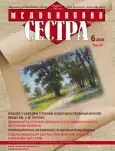Reversible cerebral vasoconstriction syndrome associated with vestibular migraine: differential diagnosis and analysis of clinical cases
- Authors: Mirzaeva L.M.1,2, Voronov V.A.1, Demidenko D.Y.1, Artemyeva V.E.1
-
Affiliations:
- North-Western State Medical University named after I.I. Mechnikov
- Clinic LMT-doctor
- Issue: Vol 27, No 6 (2025)
- Pages: 38-42
- Section: Profession: theory and practice
- URL: https://journals.eco-vector.com/0025-8342/article/view/691897
- DOI: https://doi.org/10.29296/25879979-2025-06-07
- ID: 691897
Cite item
Abstract
Headache is one of the most common complaints in neurological practice, significantly affecting patients' quality of life and represents a serious medical and social issue. Among the various causes of headache, special attention should be given to the rare condition known as Reversible Cerebral Vasoconstriction Syndrome (RCVS), which requires timely diagnosis and differentiation from other conditions including migraine and cerebrovascular pathologies. RCVS is characterized by sudden, severe (thunderclap) headaches and reversible narrowing of cerebral arteries, which can lead to serious complications such as ischemic stroke or subarachnoid hemorrhage. Despite its typical clinical picture, RCVS often remains undiagnosed due to its overlap with migraines and other primary headaches. This emphasizes the need for physicians to be aware of the syndrome and how to differentiate it from other conditions. Migraine, especially its vestibular and chronic forms, presents diagnostic challenges as it may mimic or coexist with RCVS, as demonstrated in clinical cases. Exploring the relationship between these conditions and seeking new approaches to their diagnosis and treatment remains an urgent issue in modern neurology. This article presents two cases of RCVS associated with migraine: one involving a 49-year-old woman who developed acute neurological symptoms including vestibulocerebellar syndrome and conductive hearing loss, and the other involving a 30-year-old woman who developed RCVS after prolonged use of nasal vasoconstrictors. Both cases were diagnosed using MRI and angiography and treated successfully. Appropriate treatment led to clinical improvement. Both cases highlight the importance of differentiating between RCVS and vestibular migraine or identifying their comorbid course, as well as the need for a thorough anamnesis, including information on the use of vasoconstrictor drugs. The significance of this issue emphasizes the need for a comprehensive, interdisciplinary approach to treating polymorbid patients. This approach is effectively applied in practice at the LMT-doctor clinic through the integration of doctors from various specialties.
Full Text
About the authors
Lyudmila M. Mirzaeva
North-Western State Medical University named after I.I. Mechnikov; Clinic LMT-doctor
Author for correspondence.
Email: lyudmila.mirzaeva@szgmu.ru
ORCID iD: 0000-0001-9392-1789
Candidate of Medical Sciences, neurologist, psychiatrist, assistant lecturer, Head of the Clinic
Russian Federation, Saint Petersburg; Saint PetersburgVictor A. Voronov
North-Western State Medical University named after I.I. Mechnikov
Email: viktor.voronov@szgmu.ru
ORCID iD: 0000-0002-3859-6298
Candidate of Medical Sciences, otoneurologist, associate professor
Russian Federation, Saint PetersburgDiana Y. Demidenko
North-Western State Medical University named after I.I. Mechnikov
Email: diana.demidenko@szgmu.ru
ORCID iD: 0000-0003-4604-5039
Candidate of Medical Sciences, associate professor, otoneurologist
Russian Federation, Saint PetersburgVictoria E. Artemyeva
North-Western State Medical University named after I.I. Mechnikov
Email: vika.373@icloud.com
5th year medical student
Russian Federation, Saint PetersburgReferences
- Афанасьева М.Ю., Голдобин В.В., Клочева Е.Г. Клинические проявления, факторы риска и церебральные ангиодисплазии при синдроме обратимой церебральной вазоконстрикции. Медицинский алфавит. 2020; (22): 22–26. [Afanasyeva M.Yu., Goldobin V.V., Klocheva E.G. Clinical manifestations and pathogenesis of reversible cerebral vasoconstriction syndrome. Medical Alphabet. 2020; 22: 22–26 (In Russ.)]. doi: 10.33667/2078-5631-2020-22-22–26.
- Chen S.P., Wang S.J. Pathophysiology of reversible cerebral vasoconstriction syndrome. J Biomed Sci. 2022; 29: 72.
- Кулеш А.А., Демин Д.А., Старикова Н.Л. и др. Синдром обратимой церебральной вазоконстрикции. Consilium Medicum. 2025; 27 (2): 63–69 [Kulesh A.A., Demin D.A., Starikova N.L., et al. Reversible cerebral vasoconstriction syndrome. Consilium Medicum. 2025;27(2):63–69 (In Russ.)]. doi: 10.26442/20751753.2025.2.203150.
- Сергеев А.В., Осипова В.В., Табеева Г.Р. и др. Синдром обратимой церебральной вазоконстрикции. Неврологический журнал. 2012; 17 (3): 4–11 [Sergeev A.V., Osipova V.V., Tabeeva G.R. et al. Reversible cerebral vasoconstriction syndrome. Nevrologicheskij zhurnal. 2012; 17 (3): 4–11 (In Russ.)].
- Calabrese L.H, Dodick D.W, Schwedt T.J. et al. Narrative review: reversible cerebral vasoconstriction syndromes. Ann Intern Med. 2007; 146: 34–44.
- Клочева Е.Г., Голдобин В.В. Диагностика синдрома обратимой церебральной вазоконстрикции: клинические проявления и данные методов лучевой диагностики. Лучевая диагностика и терапия. 2018; 3 (9): 50–55 [Klocheva E.G., Goldobin V.V. Diagnosis of reversible cerebral vasoconstriction syndrome: clinical manifestations and imaging data. Luchevaya diagnostika i terapiya. 2018; 3 (9): 50–55 (In Russ.)]. doi: 10.22328/2079-5343-2018-9-3-50-55
- Bousser M.G., Welch K.M. Migraine and stroke. Lancet Neurol. 2005; 4 (2): 91–98.
- Burton T.M., Bushnell C.D. Reversible cerebral vasoconstriction syndrome. Stroke. 2019; 50 (8): 2253–2258.
- Debette S., de Silva D.A. Cerebrovascular complications of RCVS. Stroke. 2011; 42 (12): 3595–3600.
- Ducros A. Reversible cerebral vasoconstriction syndrome. Lancet Neurol. 2012; 11 (10): 906–917.
- Singhal A.B. Reversible cerebral vasoconstriction syndrome: A review of pathogenesis, clinical presentation, and treatment. International Journal of Stroke. 2023; 18 (10): 1151–1160. DOI: 10. 1177/17474930231181250.
- Vgontzas A., Burch R. Episodic migraine with and without aura. Curr Pain Headache Rep. 2018; 22 (12): 78.
- Headache Classification Committee of the IHS. The International Classification of Headache Disorders, 3rd edition. Cephalalgia. 2018; 38 (1): 1–211.
- Mawet J, Kurth T, Ayata C. Migraine and stroke: in search of shared mechanisms. Cephalalgia. 2015; 35 (2): 165–181. doi: 10.1177/0333102414550106.
- Miller T.R., Shivashankar R., Mossa-Basha M. et al. Reversible cerebral vasoconstriction syndrome, part 1. AJNR Am J Neuroradiol. 2015; 36 (8): 1392–1399.
- Sacco S., Ricci S., Carolei A. Migraine and vascular diseases. Cephalalgia. 2012; 32 (10): 785–795.
- Chen S.P, Fuh J.L., Wang S.J. Reversible cerebral vasoconstriction syndrome. Ther Adv Neurol Disord. 2010; 3 (3): 161–171.
- Schwedt T.J., Dodick D.W. Thunderclap stroke. Curr Pain Headache Rep. 2006; 10 (1): 71–77.
- Radiol Med. 2002 Sep. 127 (9): 981–990.
Supplementary files







